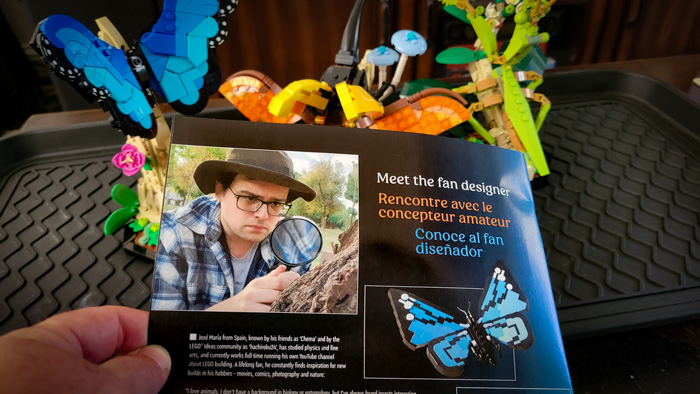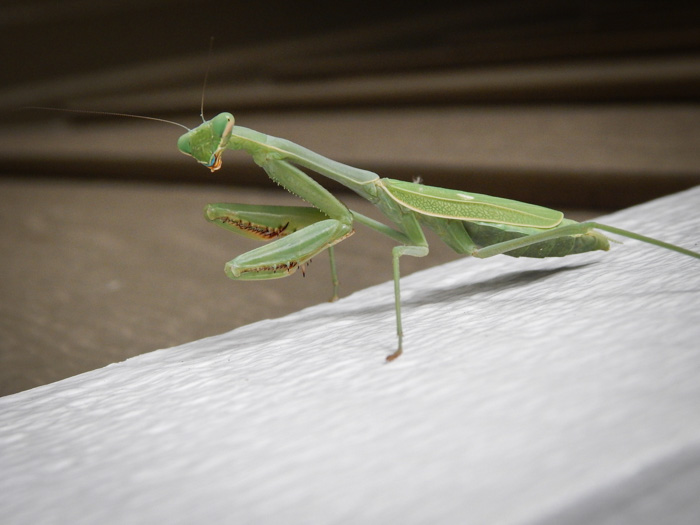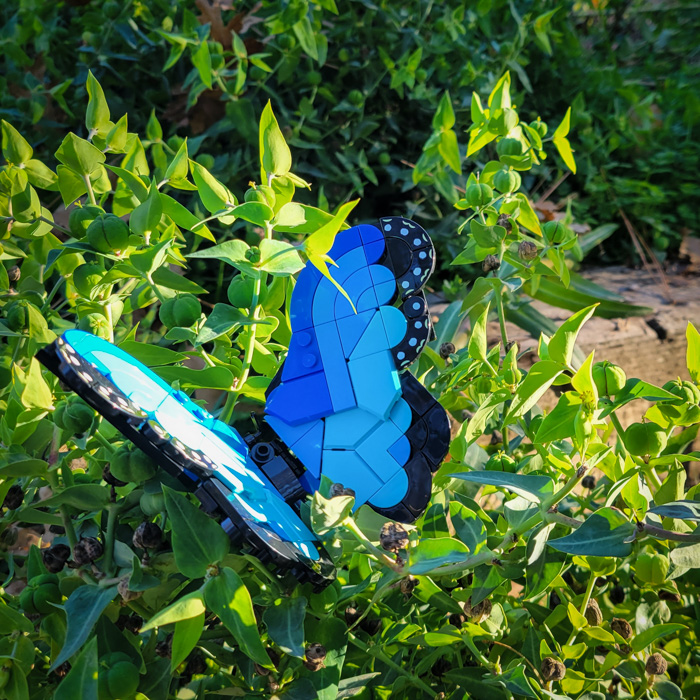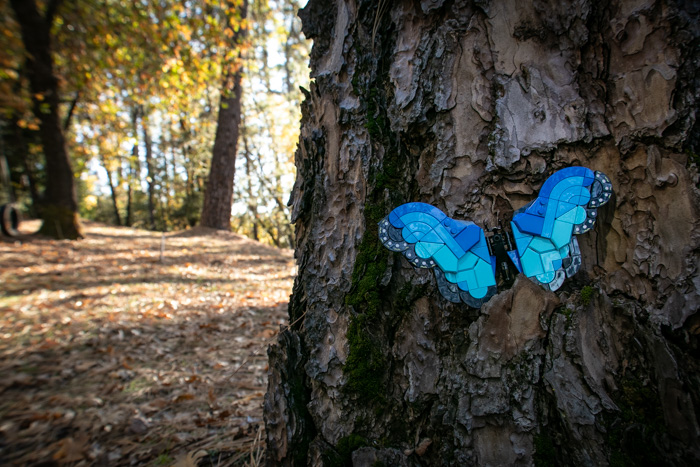When I first saw the LEGO Insect Collection, there was an immediate connection. You see, out of all the world’s creatures, there are two animals I find especially attractive and fascinating. One is the octopus. But I don’t live near the ocean–or even an aquarium!–so I rarely see these animals in person. The other is a creature that I found fascinating after spending a lot of time with it: the praying mantis. So I can relate to the Spanish fan designer of the LEGO Ideas Insect Collection, José María Pérez Suero, with his interest in insects.

~ José María Pérez Suero, LEGO fan designer
Living in Northern California, and having become an avid gardener about ten years ago, I encountered praying mantids as helpful predators that keep pest insect populations under control. You can actually buy praying mantis egg cases in gardening stores (or online) and hatch them in the spring for your garden. It was under the macro lens of my camera that I discovered the intriguing design of the mantis mouth, with its mandibles and feelers. It was while raising mantis hatchlings that I discovered how voracious (to the point of cannibalism!) these little carnivores can be. It’s not every day one can observe such ferocious predators at no risk to oneself.






Yes, I took all these photos on my own property. We have both green and brown praying mantis species. It was the joy of macro photography that led me to the joy of toy photography. Which is why you’re here, right? Onward to the toy photography review!
The LEGO Insect Collection Build
The build itself is fairly straightforward. One of the nice things about a set with three distinct items to build is that you can easily share the build process with friends or family. LEGO has anticipated this, and the instructions and parts bags are separate for each insect.
One thing caught me by surprise during the build of the Hercules beetle. As you are assembling the piece of wood that it’s mounted upon, there’s a moment when you place two white croissant pieces under the chunk of wood. There’s no structural reason for them to be there, and they aren’t visible after you place the wood where it belongs. What could they be…?

Sure enough, LEGO Ideas Design Manager Jordan David Scott says in the set pamphlet, “We have a fun little Easter egg you can only spot while you’re building the model…”
Nice touch, Jordan. Some grubs under the rotting wood where the beetle lives!
Size, sturdiness, and posability
The designers say the insects are “approximate life-size scale”, but from what I see online it varies a bit. The male Hercules beetle can reach up to 7 inches (including the horn), which is about the same as the brick version. But Chinese praying mantids are known to reach 4.3 inches (11 cm), while the brick version is closer to 7 inches. And the Blue Morpho butterfly reaches about 4.7 inches (12 cm) but the brick version is over 7 inches–quite a bit bigger!
I’m certainly not complaining, though, because the model sizes they chose work very well together. The brick engineering results in a very solid build that holds together during transport and posing for photos. I was especially pleased that the legs can actually support the weight of each insect while holding a life-like pose. Occasionally they will sink if you place the legs at certain angles, but overall the joints hold up well and provide the illusion of a real insect crawling or clinging.
Even the butterfly did reasonably well for how heavy the bricks are, and could be propped on logs or bushes for a quick photo.
Drawbacks to photography
There are a few drawbacks to toy photography “out of the box,” however. Here’s what I noticed…
The Hercules beetle build includes two cute little mushrooms, but they get in the way of a clean photograph. Same goes for the under-wings. While they make for a dramatic “about to lift-off” moment, it’s very difficult to take a photo where you can actually see the beetle’s impressive horn while putting the wings in a direction that makes it clear what’s happening. The reflective surfaces of both sets of wings really add to the challenge of photographing this model. If it’s not too blasphemous to suggest, I’d consider spraying a coat of clear matte paint on the wings to see if it helps.
Some of my experimental (aka subpar) shots as I tried to find a good angle and amount of light, as well as seeking an outdoor location that wasn’t too busy:






The wings are such a bright color and the body and horn so black, it makes for an interesting challenge to find a background that sets off both. My default LEGO settings for my Canon 80D camera also weren’t ideal. A model this large needs more depth of field to get everything in focus at once. Better if I remove my macro filter and zoom in from a distance to get some blurred background while keeping the whole model crisp (as I would with 6″ action figures instead of LEGO minifigures). In the end, I decided (at least for my tastes) this big guy was best off in a more controlled studio environment, and without his underwings. An overcast day in a less busy part of nature would probably work, too.
The Blue Morpho butterfly is rather heavy and I wasn’t prepared with ways to affix it in life-like ways to the natural environment (like trees, bushes, etc). Some creative LEGO engineering might help, or perhaps a big wad of poster putty (aka “sticky tack”). It also seems to have a limited number of angles where it looks “nice”, because the underside of the wings wasn’t designed to be photogenic.

Usually I see butterflies with their wings “up” instead of flat open, so that seems like the most natural pose. But this model isn’t really designed to accommodate that. As with the beetle, there’s a lot of surface area on the butterfly that is highly reflective and shiny, so watch out for direct sunlight or the angle of any bright lights.

Out of the box, the eyes of the Chinese praying mantis are the only thing that really bug me. The curve of the shiny round piece is easily overexposed with reflections and the soft white dots and the pupils themselves are painted a little blurry… which means no matter how “in focus” my photo is, they’ll never be as crisp as I’d like. And the pupils aren’t dark enough to “pop” in contrast, so I tend to darken them in post-production to get the effect I want.

The focus is precise enough in the above shot to see the vertical plastic mold lines on the eyes, and yet they still look “out of focus” to me because of the design. Sorry if that seems picky, but that’s art for you — each artist has their subjective tastes!
My conclusion as a photographer
Is the LEGO Ideas Insect Collection good for toy photography? Maybe. Two of the three insects have major drawbacks that detract from the joy of photographing them, at least for me. But if you ask “Is this set good for Teddi’s toy photos?” then the answer is 100% YES. And the reason is all about that absolutely gorgeous and posable praying mantis. While it has its own challenges as a model, I can work with it. Because I’m such a fan of the subject matter, it’s worth it to me to overcome them. The set is $79.99 in the LEGO store at the moment, and if you like bugs, then it’s probably “worth it” just to have them on your shelf. And sometimes, you just need to pull a bug out to attack (or befriend) one of your minifigures, amiright?



A few other shots for your enjoyment…






Other LEGO Ideas sets I enjoy:







Marvelous review, Teddi and it seems a perfect set for the insect fan!
Thank you, Mary! That praying mantis is especially so much fun!